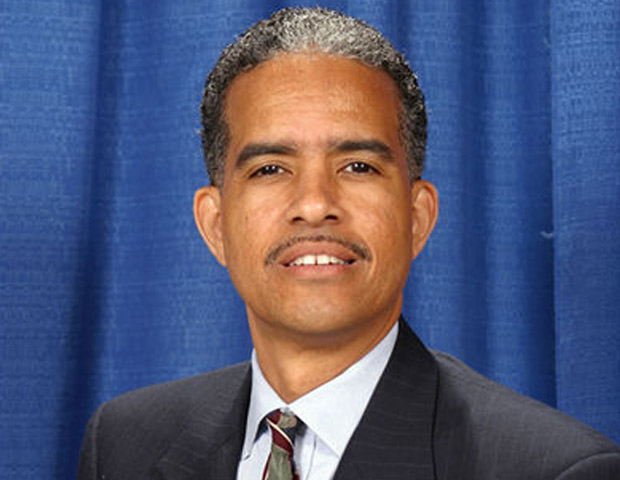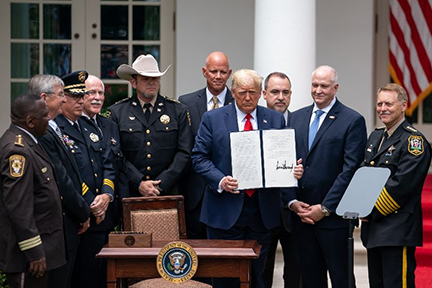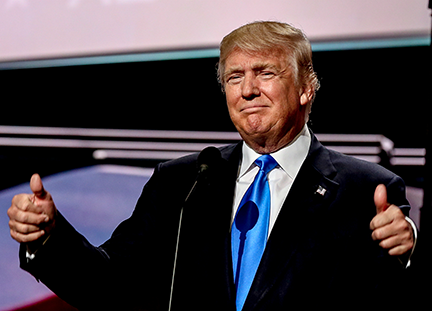California Governor Gavin Newsom announced $2.5 billion funding for COVID-19 smackdown of small businesses in his state.
Month: June 2020
David J. Byrd named National Director of Minority Business Development Agency
WASHINGTON, June 17, 2020 – Today, U.S. Secretary of Commerce Wilbur Ross announced that David J. Byrd will be the new National Director of the U.S. Department of Commerce’s Minority Business Development Agency (MBDA). Mr. Byrd will be the 18th National Director of the agency.
Established by an Executive Order in 1969, MBDA is the only Federal agency solely dedicated to the growth and global competitiveness of U.S. minority-owned businesses.
“David’s vast experience in public service and as an entrepreneur are true assets to MBDA and the Department of Commerce,” said Secretary Ross. “In his new role, I fully expect him to continue to provide the type of leadership that will lay the foundation to usher in the next 50 years of opportunities and growth for minorities as well as the country as a whole.”
Mr. Byrd is originally from New Jersey and has served in many public service roles over the years at the local, state and federal levels. Several years ago, Byrd was named by Black Enterprise Magazine as one of the “10 Black Republicans You Probably Don’t Know but Should.”
Mr. Byrd joined MBDA in October 2019 as the National Deputy Director responsible for overseeing the day-to-day departmental operations and establishing a streamlined information portal to track Agency milestones and program execution. As MBDA National Director, Mr. Byrd will oversee the development and implementation of Agency initiatives, policy agenda, and federal grant programs.
“I am honored to be selected by Secretary Ross to lead the Minority Business Development Agency”, said Mr. Byrd. “I am proud to take the helm as the National Director following several of my career mentors who were instrumental in shaping the mission and strategic direction of MBDA since its founding in 1969. I look forward to continuing the Agency’s work ensuring the resiliency and growth of America’s minority-owned firms today, tomorrow, and for future generations of minority entrepreneurs.”
Prior to accepting the fourth presidential appointment of his career at MBDA, Mr. Byrd served as the Deputy Assistant Secretary, Office of Policy Development, at the U.S. Department of Housing and Urban Development. His more than 28-year career in public service has included executive positions at the county, state, and federal levels. Mr. Byrd is also an experienced entrepreneur who owned and operated a consulting firm specializing in government relations, political consulting, executive and life skills coaching.
By Staff Writers and U.S. Department of Commerce Press Release
Join Bigwigg today. It’s free like the land and brave like our home.
Trump signs Executive Order on Safe Policing
President Trump signed his Executive Order on Safe Policing for Safe Communities, which mandates certain police reforms
May report indicates Consumer Price Index is stabilizing
Consumer Price Index (CPI) is stabilizing, according to data released today by the Bureau of Labor Statistics (BLS) for May 2020. Prices declined by only 0.1% in May, compared to the more dramatic declines of 0.4% and 0.8% in March and April, respectively.
U.S. Economy added 2.5 Million jobs in May
Represents the biggest monthly jobs gain ever recorded
WASHINGTON, DC – The U.S. Economy added 2.5 million jobs in May, which is the biggest gain ever recorded, according to the U.S. Department of Labor. These job gains coincided with the widespread lifting of COVID-19 lockdowns and the limited resumption of economic activity that had been curtailed in March and April. These additional jobs caused a drop in the unemployment rate from 14.7% down to 13.3%.
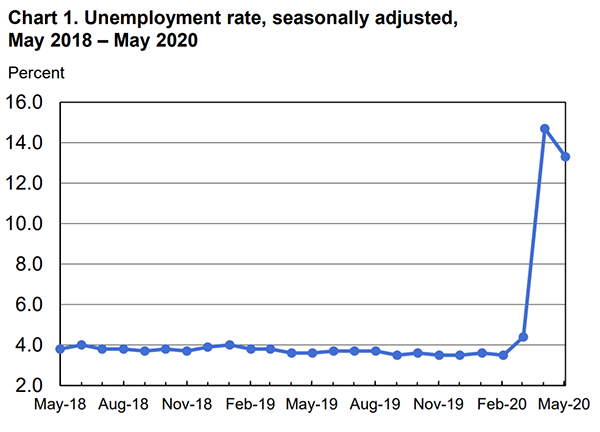
Women benefited more than men in the May jobs recovery, according the report by the Bureau of Labor Statistics (BLS). Unemployment among adult female workers decreased by 13.9%, compared to an 11.6% drop for adult male workers.
The industries that were the big winners in May were:
- Leisure and hospitality (+1,200,000 jobs)
- Construction (+464,000)
- Education and health (+424,000)
- Retail (+368,000)
- Other Services (+272,000)
- Manufacturing (+225,000)
The industries that continued to be challenged in May were:
- Government (-585,000 jobs) – most of those losses consist of public education workers
- Information (–38,000)
- Mining (-20,000)
President Trump reacted very positively to the news, as expected. “We’re bringing our jobs back,” said Trump at a White House press conference this morning. “We’ll go back to having the greatest economy anywhere in the world, nothing close.”
Most economists agree that the economy hit bottom on our about April 15th.
Jason Furman, who is currently an economics professor at Harvard and was previously President Obama’s chief economist has praise for the Trump administration’s initial handling of the COVID-19 economic aftermath, but some reservations about whether Trump will stay the course in providing the required additional stimulus. “One reason for optimism: the fiscal and monetary response to this crisis has been better than any previous crisis,” tweeted Furman. “One reason for pessimism: people who misunderstand the above and want to stop the response when more is needed.”
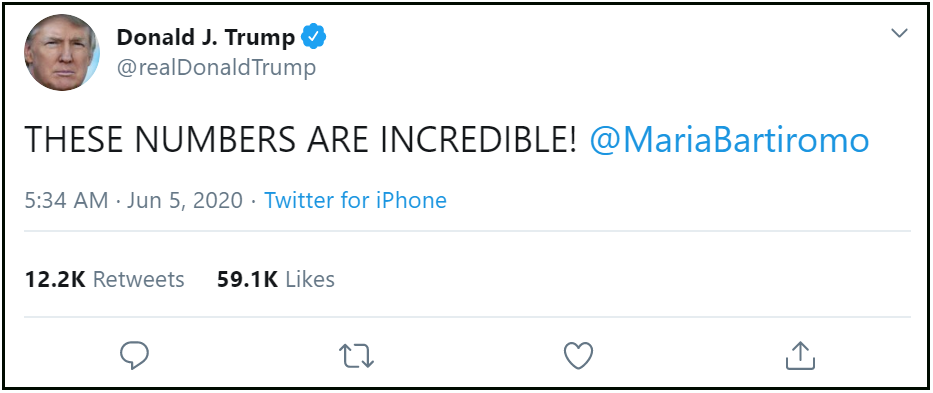
It should be noted that lockdown restrictions have only been partially lifted in most areas, and that the lifting only began in earnest in the middle of May. Thus, June could have much larger job gains. There is still a long way to go before America recovers to the employment levels before COVID-19. February 2020 represented the peak employment, at 158.8 million civilians employed. Due to the shutdown of the economy, the number of civilians employed bottomed out at 133.4 million in April of 2020. With the latest May additions, the current number of employed is 137.2 million.
Even though May’s increase is the largest monthly employment increase ever recorded, we still have a long to go before we get back to the levels before COVID-19. Nevertheless, the fact that the U.S. economy added 2.5 million jobs in May indicates that the economic recovery seems to be off to a good start. This is earlier than most of us had predicted the recovery would begin, so it can only be seen as very good news.
By Craig R. Everett, PhD. Opinions are solely my own. To follow me or add me as a friend on Bigwigg, please visit my Profile Page.
Dr. Everett is a finance professor at the Pepperdine Graziadio Business School, where he teaches entrepreneurial finance and private capital markets.
Antifa’s goals include the abolition of police and the death of America
LOS ANGELES, CA – Everyone hates fascists, so when a group like Antifa comes along and claims its name literally means “anti-fascist” it is a phenomenal branding move. It is only when you read the fine print that you realize that, to Antifa, everyone except them is a fascist, including you. For Antifa, fighting fascism includes doing many things that most Americans, even those on the far-left, would find objectionable. Antifa’s goals include the abolition of police and the death of America, among other terrifying objectives.
Who is this group and what do they want? The original Antifa was formed in the early 1930’s in Germany as Antifaschistische Aktion, known as Antifa for short. It was organized by the Stalinist Communist Party of Germany and they considered all non-communist political parties to be fascists. Ironically, Antifa cooperated with the Nazis in trying to destroy the social democrat Weimar Republic. Antifa considered both groups to be fascist, of course, but they made the mistake of believing the Nazis were less dangerous just because they were smaller. Big mistake. When the brutal Nazis came to power in Germany, Antifa was eliminated.
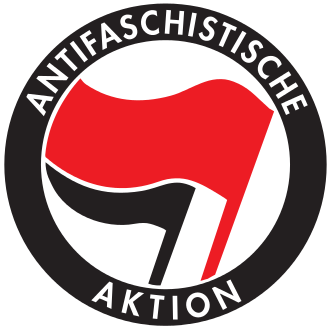
Modern Antifa was resurrected in the 1970’s as a left-wing student movement founded in West Germany by the Maoist Communist League. They adopted the same logo as the pre-war Antifa, with one small change. The old logo had two red flags, symbolizing communism and socialism. The new logo replaced the one of the red flags with a black flag. The red flag now represents communism and socialism, and the smaller black flag represents anarchism and autonomism. By the late 1980’s, Antifa was no longer associated with any political party and was more strongly leaning in the anarchist direction. In fact, some modern Antifa flags have the larger flag in black, implying that they are more strongly anarchist than communist.
Les Miserables fans might be under the mistaken impression that red represents the blood of angry men and black is the dark of ages past. We stand corrected.
Antifa is not hierarchical nor centrally-controlled. Antifa groups spontaneously emerge whenever there is a group of people who ascribe to their anti-authoritarian, anti-government, anti-capitalist beliefs, and are willing to pursue those beliefs using “direct action,” which generally means some sort of militancy. Antifa members do not typically engage in political behavior to affect policy, because they do not consider the political system to be legitimate.
Revolutionary Abolitionist Movement
The Revolutionary Abolitionist Movement (RAM), according to its founders, thinks of itself an antifa (lowercase), rather than part of Antifa proper. References to RAM started appearing on the internet in 2017, so it is fairly new organization and very few people have even heard of it, despite its influence. Most people associated with RAM are also part of Antifa, since both groups share much of the same anarchist ideology and goals. The photo on the RAM website of the Philadelphia chapter has a RAM banner in the front, and an Antifa banner in the back.
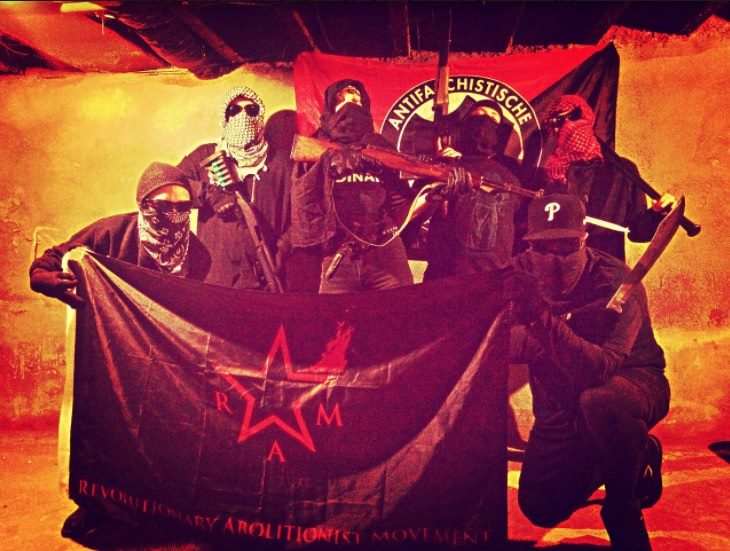
Both Antifa and RAM are anarchist movements, which means that their goal is a society without any government at all. The primary difference between the two groups is the black liberation focus of RAM. The word “abolitionist” in the name refers to the belief of those within the movement that black people in the U.S. are still living under a form of slavery, and the only path to true freedom is a revolution that ends the American government. Thus, RAM has the same ultimate goal as Antifa (ending the American government), but has a significantly different motivation behind that goal.
RAM’s founders are community organizers from The Base, which is an anarchist headquarters in the Bushwick area of Brooklyn, New York. In its writings, the group seems to draw inspiration from Eldridge Cleaver’s Black Liberation Army (BLA), which was the direct-action successor of the Black Panther Party. Again, direct action is generally a euphemism for violent protest.
RAM’s goals, or “10 Points of Action,” are largely similar to Antifa’s objectives, but also include black liberation items. The following list is taken directly from the RAM website:
Revolutionary Abolitionist Movement 10 Points of Action
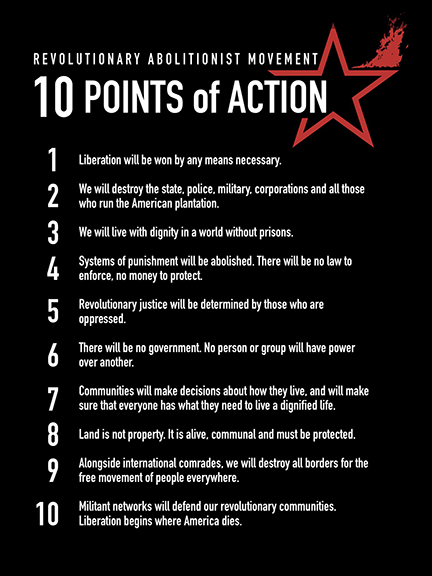
- Liberation will be won by any means necessary.
- We will destroy the state, police, military, corporations and all those who run the American Plantation.
- We will live in dignity in a world without prisons.
- Systems of punishment will be abolished. There will be no law to enforce, no money to protect.
- Revolutionary justice will be determined by those who are oppressed.
- There will be no government. No person or group will have power over another.
- Communities will make decisions about how they live, and will make sure that everyone has what they need to live a dignified life.
- Land is not property. It is alive, communal and must be protected.
- Alongside international comrades, we will destroy all borders for the free movement of people everywhere.
- Militant networks will defend our revolutionary communities. Liberation begins where America dies.
It is important to distinguish these anarchist groups from #BlackLivesMatter (BLM), which is a black liberation organization (according to their website) founded in 2013 in response to the jury acquittal of Trayvon Martin’s killer. Rather than being a pure anarchist group, BLM is more narrowly focused on the goals of ending white supremacy and police brutality. These are goals that nearly every person of every race embraces, so BLM enjoys widespread public support.
In the latest BLM protests surrounding the killing of George Floyd by police in Minneapolis, we have witnessed a disturbing trend. The peaceful BLM protests that occur during the day have often transformed into violent riots, looting and destruction at night. It is unlikely that this is randomly occurring. The difference appears to be the after-dark arrival of anarchist groups such as Antifa and RAM, whose goals are much more extreme than BLM’s and who provoke violent clashes with police in order to capture video footage of it, presumably for propaganda purposes.
By definition, the anarchists have no political goals, so negotiation with them is unlikely to be effective. They are not, for example, seeking the passage of anarchist-friendly legislation. They simply want to take down the American government and will do so by any means necessary. RAM and Antifa’s goals include the abolition of police and the death of America as a sovereign country, so Americans ignore these groups at their own peril. As the anarchist groups continue to fail in achieving their goals, their militant tactics are likely to become more violent over time, not less. The anarchists that can be seen at protests do not want to end police brutality, they want to end the police itself. They do not want to end injustice in America, they want to end America itself.
There are many legitimate channels for enacting change in our society, but sedition is not one of them.
By Sarah Jones-Koskinen. Opinions are my own. To follow me or add me as a friend on Bigwigg, please visit my Profile Page.
On Bigwigg there is no shadow-banning or ideological censorship. Join Bigwigg today for free and invite your friends. ![]()



